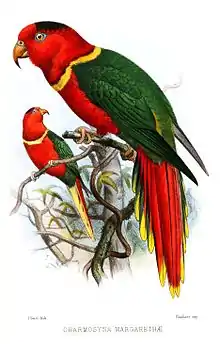Duchess lorikeet
The duchess lorikeet (Charmosyna margarethae), is a species of parrot in the family Psittaculidae. It is found on Bougainville Island in Papua New Guinea and in the Solomon Islands. Its natural habitats are subtropical or tropical moist lowland forest, subtropical or tropical moist montane forest, and plantations. It is threatened by habitat loss.[1]
| Duchess lorikeet | |
|---|---|
 | |
| Scientific classification | |
| Kingdom: | Animalia |
| Phylum: | Chordata |
| Class: | Aves |
| Order: | Psittaciformes |
| Family: | Psittaculidae |
| Genus: | Charmosyna |
| Species: | C. margarethae |
| Binomial name | |
| Charmosyna margarethae Tristram, 1879 | |
Taxonomy
English naturalist Henry Baker Tristram described the species in 1879.
"Duchess lorikeet" has been designated the official name by the International Ornithologists' Union (IOC).[2]
Description
The duchess lorikeet is 20 cm (8 in) in length, and weighs 40-60 g.
Adult duchess lorikeets are mainly bright red in color, with purple to black hindcrowns and yellow-orange eyes. It has an orange bill. It has a wide yellow chest band along with a thin yellow collar on the mantle bordered by a purple or black line. It has a dull mauve to black lower breast, with dull yellow underwings. Its tail are red, with green upper tail coverts and yellow tips. Females look the same as males, but additionally have yellow patches on the side of the rump.
Juveniles lorikeets have black markings on the head and underparts, along with a dusky black patch on the occiput. The breast band is a faint yellow and the yellow collar on the mantle has a dusky wash. They have a brown to black bill, with grey eyes.[3]
Distribution and habitat
The species is found only on Bougainville Island and 6 islands in the Solomon Islands. It is a localised species that is absent from large areas of habitat in its range that are potentially suitable for it. It is most often found in lower montane forest and in coconut plantations. It is found from sea level to an elevation of 1,350 m asl. It may be nomadic and inhabit habitats at different altitudes.[4]
Behavior and Ecology
The calls of the duchess lorikeet are generally more squeaky than that of other species of lorikeets. Their flight calls are loud and high-pitched, while high-pitched screek notes are made while feeding.[5]
Food and feeding
The lorikeet mostly feed on nectar, pollen, and small fruits, especially Schefflera.[4]
Threats
Much of the lowland forest in its range is scheduled to be logged, although it could survive at higher altitudes. Another threat to the species is the possibility of large scale pet trade.[4]
In culture
It was featured on a stamp for the Solomon Islands made in 1975.[6]
Status
The species is widespread and relatively common through its range, but the population may decline rapidly in the future if large scale pet trade begins. Consequently, the species is considered to be near-threatened by BirdLife International and the IUCN.[4]
Aviculture
The species is traded in the pet trade, but there is an export quota of 60 birds per year to avoid population decline.[4]
References
- BirdLife International (2020). "Charmosyna margarethae". IUCN Red List of Threatened Species. 2020. Retrieved 26 April 2020.
- Gill, Frank; Donsker, David, eds. (2020). "Parrots & cockatoos". World Bird List Version 10.1. International Ornithologists' Union. Retrieved 26 April 2020.
- "Duchess Lorikeet (Charmosyna margarethae) | Parrot Encyclopedia".
- "Duchess Lorikeet Charmosyna margarethae".
- "Duchess Lories | Beauty of Birds". www.beautyofbirds.com. Retrieved 2020-04-24.
- "$2 Dutchess Lorikeet single | National Postal Museum". postalmuseum.si.edu. Retrieved 2020-04-24.
